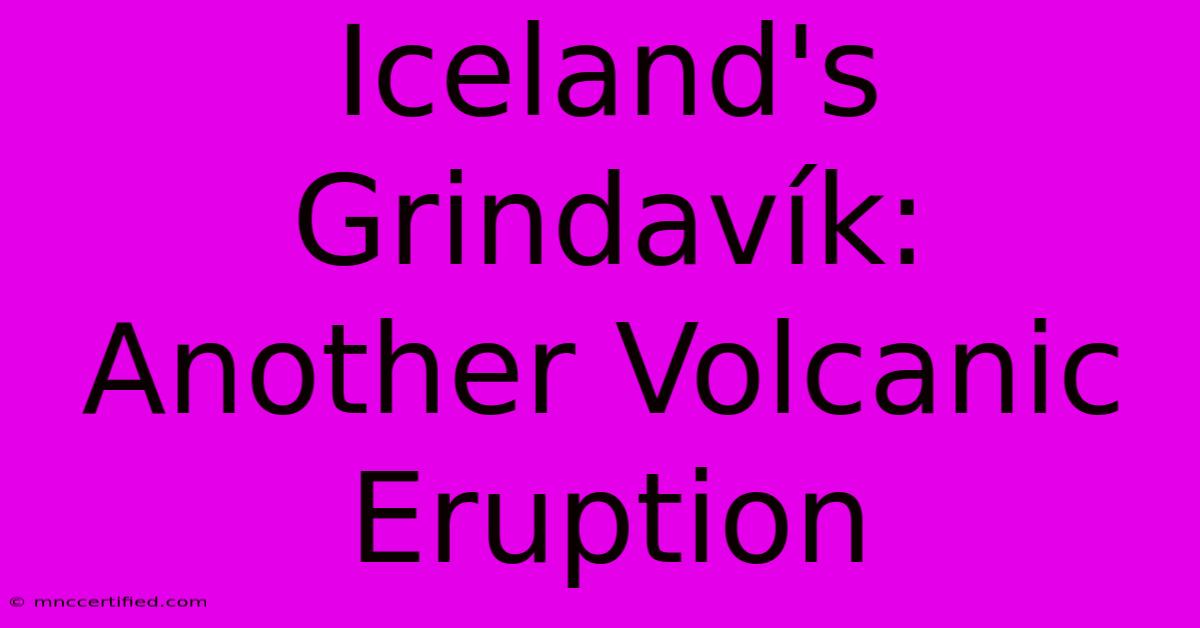Iceland's Grindavík: Another Volcanic Eruption

Table of Contents
Iceland's Grindavík: Another Volcanic Eruption – A Closer Look
Iceland, the land of fire and ice, has once again captured global attention with volcanic activity near Grindavík. This article delves into the recent eruption, its impact, and what it means for the future of this captivating island nation. We'll explore the geological context, the ongoing response, and the enduring allure of Iceland's dramatic landscape.
Understanding the Grindavík Eruption
The eruption near Grindavík, while not as visually spectacular as some previous Icelandic eruptions, presents a unique set of challenges. Unlike the explosive eruptions of Eyjafjallajökull in 2010, this event is characterized by effusive volcanism, meaning the lava flows relatively slowly. This doesn't diminish its significance; the slow, steady flow of lava poses a serious threat to infrastructure, including the town of Grindavík itself.
Geological Context: The Reykjanes Peninsula
The eruption is located on the Reykjanes Peninsula, a volcanically active region situated on the Mid-Atlantic Ridge, where the North American and Eurasian tectonic plates meet. This geological setting makes Iceland particularly prone to volcanic activity. The recent series of eruptions on the peninsula highlights the dynamic nature of this geological boundary. Understanding this context is crucial for comprehending the ongoing events and predicting future volcanic activity in the region.
The Impact on Grindavík and Surrounding Areas
The lava flows have caused significant disruption to the town of Grindavík. Evacuations were implemented to ensure the safety of residents, and the town's infrastructure, including roads and geothermal plants, faces substantial damage. The impact extends beyond Grindavík, affecting tourism and local economies reliant on the area's natural beauty and geothermal resources. The long-term economic consequences are still being assessed.
Ongoing Response and Monitoring Efforts
Icelandic authorities have responded swiftly and effectively to the eruption. Monitoring systems are constantly tracking the lava flow, gas emissions, and seismic activity. This real-time data is crucial for informing evacuation orders and managing the crisis effectively. International collaboration plays a vital role in sharing expertise and resources during this challenging period.
Iceland's Volcanic Tourism: A Double-Edged Sword
Iceland's stunning landscapes, including its active volcanoes, are a major draw for tourists. The recent eruption near Grindavík presents a double-edged sword. While the immediate impact is negative, with disruptions to travel and tourism, the long-term effect might be different. The eruption could potentially draw even more tourists fascinated by the raw power of nature. Responsible tourism is crucial, ensuring visitor safety and minimizing environmental impact during and after such events.
The Future of Grindavík and Iceland's Volcanic Landscape
The long-term recovery of Grindavík will require significant effort and investment. Rebuilding infrastructure, supporting displaced residents, and addressing the economic consequences will be a key priority. However, the resilience of the Icelandic people and their ability to adapt to challenging circumstances should not be underestimated.
The ongoing volcanic activity serves as a stark reminder of Iceland's unique geological setting and the inherent risks associated with living in such a dynamic environment. It also underscores the importance of robust monitoring systems, effective emergency response plans, and a deep understanding of volcanic processes.
The story of Grindavík's eruption is far from over. It's a story of resilience, adaptation, and the ongoing interplay between human society and the powerful forces of nature. As events unfold, the world will continue to watch, fascinated and concerned, as Iceland grapples with its fiery heart.
Keywords: Iceland volcano, Grindavík eruption, Reykjanes Peninsula, volcanic activity, effusive volcanism, lava flow, evacuation, tourism, geological context, Mid-Atlantic Ridge, Iceland tourism, natural disasters, volcanic monitoring, Icelandic authorities, responsible tourism, recovery efforts.

Thank you for visiting our website wich cover about Iceland's Grindavík: Another Volcanic Eruption. We hope the information provided has been useful to you. Feel free to contact us if you have any questions or need further assistance. See you next time and dont miss to bookmark.
Featured Posts
-
Coral Gables Palace World Documentary
Nov 22, 2024
-
Penn States Live Impact Map
Nov 22, 2024
-
Huda Kattans Black Friday Beauty Sale
Nov 22, 2024
-
Illinois Court Overturns Smollett Verdict
Nov 22, 2024
-
Another Eruption Icelands Reykjanes Volcano
Nov 22, 2024